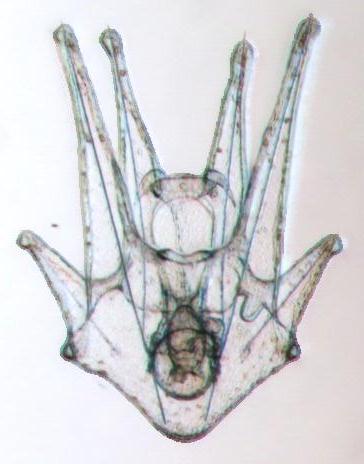Pluteus larvae of the green sea urchin “Strongylocentrotus droebachiensis”
What would you do if I give you 1 million euros to investigate the impact of ocean acidification?
There is no good or bad answer to this (tricky) question. There is so much to be done. But we all agree that it is important to collect data that are as realistic as possible, as closely related to the real world, and that allow to make projection on what may happen in the future.
One way to increase the realism of an experiment is to use mesocosms. You capture a part of the ecosystem with all its complexity and you manipulate the pCO2. This is what is done during the KOSMOS 2013 campaign.
My lab is taking another approach. We work in highly controlled environments in the lab and we try to understand the mechanisms behind an organism’s response and how this related to their biology. Our grail is the “unifying principles” that would allow to predict future changes without having to test all species and all ecosystems (an impossible task, anyway). If you understand why a species is responding in a certain way, you can then predict what may happen in the future.
Over the last years, we have been investigating how ocean acidification impacts sea urchin larvae.
Using a range of techniques from genomics to organism physiology, we’ve shown that when exposed to ocean acidification, sea urchin larvae were growing slower. This is reflecting additional costs to cope with the disturbance of their internal acid-base balance. Similarly, if I put you in a fridge without warning, you’ll need more energy to keep warm and you willl have less energy to do other things.
The last question we are trying to answer is how organism responds to fluctuating environment. Most experiments to date are done in constant pH condition. For example, you compare the response of an organism at a pH of 8.1 (present) compared to 7.7 (projected for 2100). But in the real word, pH is fluctuating and we know that organisms are able to “buffer” pH changes to a certain extend. For example, you would be able to survive in a fridge for a little while but not forever. The question is then not only “how much” you can cope with but “how much for how long”.
Based on experiments in the lab and use of mathematical models, we are now able make predictions on how sea urchin larvae would react in the real work. But we still need to test its validity. To do so, I would need 1 million euro. Such experiments are extremely challenging and do require coordination between many scientists. But you know what? I am lucky because this year, BIOACID decided to perform a mesocosm experiment just in front of my lab and the KOSMOS mesocosms is the perfect playground to test my model.
So, later this week, we will move out of the laboratory and put some of our larvae in the mesocosms. We will prepare sea urchin larvae (keep an eye on this blog, I’ll write the recipe very soon) and add 100 000 in each mesocosm. Then we will check how fast they grow and how they survive. This will allow us to check if our predictions are accurate. If not, I guess it will be time to change our way of working.
Welcome (back) to the real world, sea urchin larvae.
To be continued
